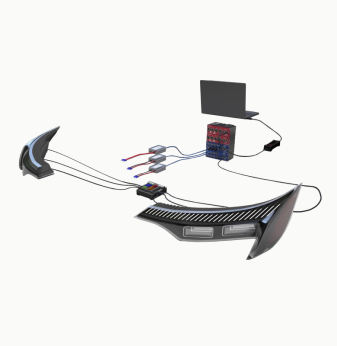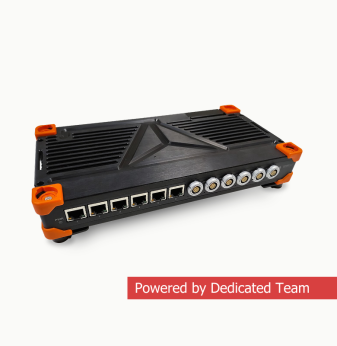WebAssembly for Embedded Systems: A New Era of Cross-Platform Firmware

The Challenge of Fragmentation in Embedded Development
Embedded systems have always been defined by diversity — of architectures, toolchains, and operating systems.
A team working on an industrial gateway may use ARM Cortex-A with Linux, while another builds on an ESP32 or a RISC-V microcontroller. Each platform has its own compilers, debuggers, and dependency quirks.
This fragmentation makes firmware development expensive and time-consuming. Reusing code between products or migrating from one SoC vendor to another can mean rewriting thousands of lines.
Now, a new technology born in web development is quietly changing that equation: WebAssembly (Wasm).
Originally designed to make browsers faster, Wasm has evolved into a universal, platform-independent runtime — one that could reshape how we build and deploy embedded software.
What WebAssembly Brings to Embedded
WebAssembly is a binary instruction format designed for high performance and security. Code compiled into Wasm runs inside a lightweight virtual machine, independent of the host architecture.
In practice, this means a single firmware module can run across different processors and operating systems — from Linux-based gateways to microcontrollers — with minimal changes.
Key properties that make Wasm attractive for embedded developers include:
– Portability: “Write once, run anywhere” finally applies to firmware.
– Security sandboxing: Each Wasm module runs in isolation, limiting potential system damage from bugs or exploits.
– Efficiency: The binary format is compact, loads fast, and runs near-native speed.
– Extensibility: Modules can be updated or replaced individually, ideal for modular firmware and over-the-air (OTA) updates.
In essence, WebAssembly acts as a common layer between applications and hardware — a universal runtime for the embedded world.
Why Embedded Developers Are Paying Attention
The timing couldn’t be better. The embedded ecosystem is facing three converging pressures:
- The rise of IoT and edge AI. Devices need frequent updates, dynamic workloads, and runtime flexibility — all difficult to achieve with static binaries.
- Cross-platform complexity. Supporting multiple architectures in one product family multiplies maintenance effort.
- Security and reliability. The growing attack surface of connected devices demands stricter runtime isolation and memory safety.
WebAssembly directly addresses all three. By separating logic from the underlying platform, it lets developers deliver portable, sandboxed applications that can be easily maintained and secured.
WebAssembly vs. Traditional Firmware
Traditional firmware is tightly coupled to its hardware. It’s compiled for a specific architecture, often using proprietary SDKs and toolchains. Updating or porting it requires recompiling everything and ensuring compatibility with drivers, interrupts, and peripherals.
Wasm changes this model entirely. Instead of building monolithic binaries, developers can package logic as modular Wasm components, each compiled from high-level languages such as C, C++, or Rust.
These modules are executed inside a WebAssembly runtime — a small, efficient virtual machine embedded in the device firmware.
Think of it like a virtualized layer that interprets portable bytecode, just as Java did for enterprise software decades ago — but faster, smaller, and safer.
How It Works in Embedded Context
In an embedded device, the Wasm runtime typically coexists with native firmware. It handles high-level or non-critical tasks, while time-sensitive logic remains on bare metal or RTOS-managed cores.
A typical setup looks like this:
– The base firmware manages hardware interfaces (GPIO, I2C, SPI, etc.).
– A Wasm runtime like Wasm3, WAMR (WebAssembly Micro Runtime), or Wasmer runs on top.
– Application logic — for instance, sensor calibration, data processing, or communication protocol — is compiled to WebAssembly modules.
When the device boots, it loads the appropriate Wasm module, executes it securely within the sandbox, and can swap it dynamically if needed.
This structure decouples firmware logic from the hardware layer, dramatically simplifying maintenance and updates.
Security by Design
WebAssembly’s sandbox model provides a key advantage for connected embedded systems.
Each Wasm module runs in an isolated memory space. It can only access functions explicitly exposed by the host firmware — for example, sending data over UART or toggling LEDs.
This means that even if a module crashes or is compromised, it cannot directly harm other parts of the system.
For IoT and industrial devices, this model aligns perfectly with modern cybersecurity principles like zero trust and defense in depth. It allows secure remote updates, third-party plugins, and dynamic code loading without exposing the system kernel.
Cross-Platform Development: From Concept to Practice
Imagine a company producing smart home devices — thermostats, sensors, and controllers — each built on a different SoC.
Traditionally, the firmware for each model would require a separate codebase. With WebAssembly, developers can write a single core logic module (for example, temperature regulation or data aggregation) and deploy it across all devices.
The only difference lies in the underlying host layer — the part responsible for connecting Wasm to the specific hardware.
This dramatically reduces development cycles, accelerates testing, and ensures consistent functionality across the product line.

Benefits for Embedded Vendors and OEMs
- Reduced vendor lock-in. Teams can migrate between microcontrollers or chipsets without rewriting the application logic.
- Faster feature rollout. Updates can be delivered as Wasm modules instead of full firmware images — smaller, safer, and easier to validate.
- Ecosystem expansion. OEMs can open their platforms to external developers, offering SDKs to build custom Wasm extensions safely.
- Future readiness. As hardware evolves, Wasm modules remain portable, protecting software investment across product generations.
This approach mirrors what’s already happened in cloud and mobile ecosystems — a modular, service-based software structure replacing monolithic builds.
Integrating WebAssembly with RTOS and Edge AI
Wasm doesn’t aim to replace RTOS; it complements it.
For instance, an embedded vision device might use FreeRTOS for real-time control while running a Wasm runtime on a higher core for AI preprocessing or network communication.
The combination of RTOS determinism and Wasm flexibility bridges the gap between static control loops and dynamic user-facing functionality.
With advances in embedded AI, Wasm can also run pre-compiled ML models at the edge. Developers can deploy model updates as Wasm modules, ensuring version consistency across devices — a major improvement over ad-hoc binary updates.
Performance Considerations
While WebAssembly is fast, it’s not magic. Its execution speed depends on runtime implementation and available hardware acceleration.
For high-performance devices (ARM Cortex-A, RISC-V multicore), near-native speed is achievable. On constrained MCUs, developers may need to optimize runtimes and precompile Wasm bytecode into native instructions (AOT — ahead of time).
Hybrid systems use a mixed approach: Wasm for flexible, high-level logic; native code for timing-critical routines.
This partitioning ensures both agility and real-time reliability.
Tooling and Ecosystem Maturity
The WebAssembly ecosystem has matured rapidly. Projects like:
– WAMR (WebAssembly Micro Runtime) by Intel,
– Wasm3 — a tiny interpreter optimized for microcontrollers,
– Wasmer Embedded,
– and WASI (WebAssembly System Interface) for standardizing APIs,
are now bridging the gap between cloud-native and embedded worlds.
Developers can use familiar languages like C/C++, Rust, or TinyGo, compile once, and deploy on virtually any Wasm-enabled device.
These tools are still evolving, but they’re already stable enough for real-world prototypes and small-scale production.
Use Cases Emerging Across Industries
Industrial Automation: Modular control logic that can be updated independently of the main firmware.
IoT Gateways: Secure sandboxing for third-party applications and protocol adapters.
Automotive Systems: In-vehicle infotainment and connectivity layers that need dynamic updates without re-flashing the ECU.
Consumer Electronics: Plugin-based ecosystems — allowing developers to extend device functionality safely.
Energy and Smart Grid Devices: Securely running grid control algorithms or tariff logic updates in real time.
WebAssembly’s neutrality makes it suitable anywhere embedded systems require both flexibility and safety.
Limitations and Engineering Trade-Offs
Despite its promise, Wasm adoption in embedded comes with challenges:
– Memory footprint: runtimes add extra kilobytes, which may not fit ultra-low-power MCUs.
– Limited hardware access: sandboxing restricts direct peripheral control, requiring careful host API design.
– Toolchain maturity: debugging and profiling tools are still catching up with native environments.
– Cultural shift: embedded engineers must adapt to modular, abstracted development styles.
However, as runtimes become more optimized and microcontrollers more powerful, these constraints are steadily diminishing.
The Road to Cross-Platform Firmware
The evolution of embedded development mirrors what happened in web and cloud computing — moving from monolithic binaries to modular, portable codebases.
WebAssembly represents a step toward firmware as a platform, where hardware details fade into the background and developers focus on logic, security, and innovation.
In the long term, we may see standardized Wasm layers for embedded devices — where firmware components are distributed like apps, versioned, and deployed across entire fleets.
The idea of cross-platform firmware is no longer a dream — it’s quietly becoming reality.
AI Overview
Key Applications: embedded firmware modularization, IoT device updates, secure sandboxing for third-party logic, and cross-platform embedded development.
Benefits: portability across architectures, reduced maintenance cost, secure runtime isolation, faster updates, and longer product lifecycles.
Challenges: runtime overhead on constrained MCUs, limited peripheral access, evolving toolchains, and developer adoption curve.
Outlook: WebAssembly is emerging as a universal runtime for embedded and IoT devices, bridging hardware diversity and enabling agile, cloud-inspired firmware design.
Related Terms: WASI, WAMR, sandboxed execution, portable embedded runtime, firmware modularity, heterogeneous SoC.
Our Case Studies












